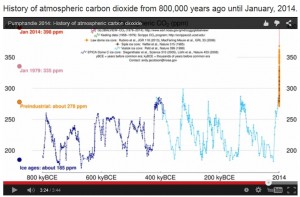According to Scientific American, “on Tuesday, the Mauna Loa Observatory recorded its first-ever carbon dioxide reading in excess of 410 parts per million (it was 410.28 ppm in case you want the full deal). Carbon dioxide hasn’t reached that height in millions of years. It’s a new atmosphere that humanity will have to contend with, one that’s trapping more heat and causing the climate to change at a quickening rate.” Normally the CO2 levels are highest in spring just before the vegetation in the lane-rich Northern Hemisphere starts sucking it up as growth resumes in the warmer weather. But even though the CO2 levels may temporarily swing down in NH summer, next year’s spring values are likely to be even higher. You can read more about it here.
Where is all this carbon dioxide coming from? The evidence is clear that it is primarily fossil fuels, which are used in energy production and transportation, based on radiocarbon dating of atmospheric carbon. I’ve heard lots of arguments against this over time, and rather than discuss them all I will refer you to Skeptical Science here, which lists objections and answers on many climate-related topics. (Note that animal agriculture in the US produces only about 6 percent of all greenhouse gas emissions because our production system is very efficient, although it is higher in developing countries).
Increases in carbon dioxide are not all bad. Evidence has shown that with higher levels of CO2 in the atmosphere, plants grow more rapidly. NOAA released a new report this week that suggests that plant growth in the higher CO2 atmosphere is surging across the globe. That is good because it is removing CO2 from the atmosphere and storing it in the plants, reducing the heat-trapping impacts of CO2 in the atmosphere. But it can also be bad because some plants are better at using the carbon dioxide to grow than others are, and many of the most prolific growers are plants that agricultural producers consider weeds. And of course the plants will only grow if they have good soils and enough water to sustain them, both of which are becoming more challenging over time.
